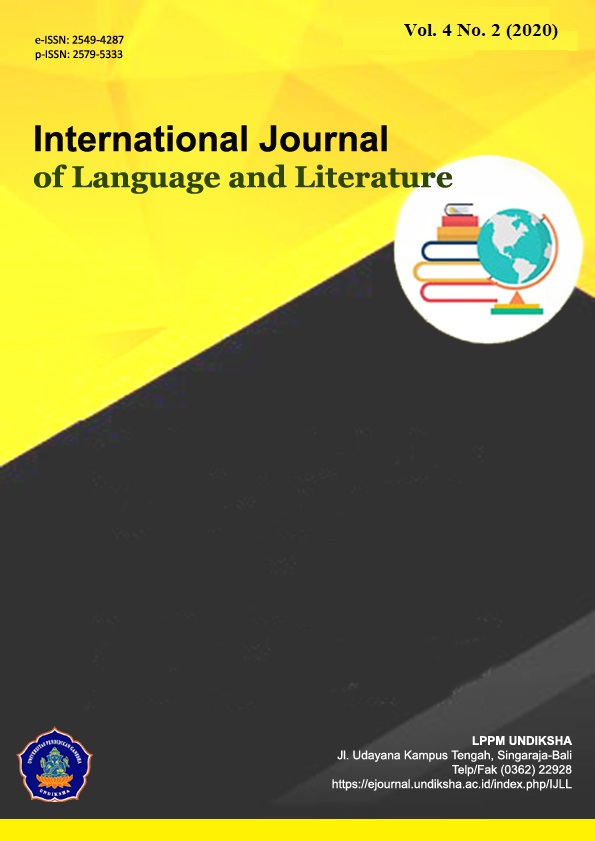A CASE STUDY OF THE SEATING ARRANGEMENT OF THE EIGHTH GRADE STUDENTS
DOI:
https://doi.org/10.23887/ijll.v4i2.30293Kata Kunci:
classroom management, seating arrangement, seating choicesAbstrak
This research aimed at observing the set-up of the seating arrangement during the instructions and identifying the students' reasons for having seating preferences. This study was conducted in SMP Negeri 1 Banjar, and the subjects were 32 students in 8F class. Two methods were applied in this study, namely observation and interview. Therefore, observation checklist and interview guide were used as the instruments. The results revealed that the set-up of the seating arrangement supported them in terms of comfort, flexibility in doing activities, doing tasks, spaciousness, and collaboration with the students. Meanwhile, it did not support them in terms of concentration, participation in class discussion, and collaboration with the teacher. Regarding their reasons for having particular seats, there were 14 reasons mentioned during the interview. Best friends and leaning on the wall were the factors that had the most and the least effect on the students in choosing their seats.Referensi
Barkley, E. F. (2010). Student engagement techniques: A handbook for college faculty (1st ed.). San Fransisco: Jossey-Bass.
Brown, H, D. (2000). Teaching by principles: An interactive approach to language pedagogy (second edi.). California: Pearson ESL.
Burda, J. M., & Brooks, C. I. (1996). College classroom seating position and changes in achievement motivation over a semester. Psychological Reports, 78(1), 331–336. DOI: https://doi.org/10.2466/pr0.1996.78.1.331
Cornell, P. (2002). The impact of changes in teaching and learning on furniture and the learning environment. New Directions for Teaching and Learning, 92, 33–42. DOI: https://doi.org/10.1002/tl.77
Correa, R., Lara, E., Pino, P., & Vera, T. (2017). Relationship between group seating arrangement in the classroom and student participation in speaking activities in EFL classes at a secondary school in Chile. Folios, 45(1), 145–158. DOI: https://doi.org/10.17227/01234870.45folios145.158
Daddi, H., & Ul Haq, M. Z. (2014). Lecturer’s strategies in English speaking class. Exposure : Jurnal Pendidikan Bahasa Dan Sastra Inggris, 3(1), 54. DOI: https://doi.org/10.26618/ejpbi.v3i1.798
Denscombe, M. (2014). The good research guide: Fourth edition (fourth edi.). UK: Open University Press.
Dincer, A., & Yesilyurt, S. (2017). Motivation to speak English: A self-determination theory perspective. PASAA: Journal of Language Teaching and Learning in Thailand, 53(June), 1–25.
Harmer, J. (2007). The practice of English language teaching (fourth edi.). England: Pearson Education Limited.
Harvey, E., & Kenyon, M. (2013). Classroom seating considerations for 21st century students and faculty. Journal of Learning Spaces, 2(1).
Hausman, D. M. (2005). Sympathy, commitment, and preference. Economics and Philosophy, 21(1), 33–50. DOI: https://doi.org/10.1017/S0266267104000379
Kementrian Pendidikan. (2016). Peraturan menteri pendidikan dan kebudayaan Republik Indonesia Nomor 22 tahun 2016 tentang standar process pendidikan dasar dan menengah. Jakarta: Kementrian Pendidikan.
Kementrian Pendidikan. (2018). Peraturan menteri pendidikan dan kebudayaan Republik Indonesia Nomor 35 tahun 2018 tentang perubahan atas peraturan menteri pendidikan dan kebudayaan nomor 58 tahun 2014 tentang kurikulum 2013 sekolah menengah pertama/madrasah tsanawiyah. Jakarta: Kementrian Pendidikan.
Kementrian Pendidikan dan Kebudayaan. (2017). Model silabus mata pelajaran sekolah menengah pertama/madrasah tsanawiyah (SMP/MTs). Jakarta: Kementrian Pendidikan dan Kebudayaan.
Losonczy-Marshall, M., & Marshall, P. D. (2013). Factors in student seat selection: An exploratory study. Psychological Reports, 112(2), 651–666. DOI: https://doi.org/10.2466/11.07.PR0.112.2.651-666
McCorskey, J. C., & McVetta, R. W. (1978). Classroom seating arrangements: Instructional communication theory versus student preferences. Communication Education, 27(2), 99–111. DOI: https://doi.org/10.1080/03634527809378281
Morrison, T. L., & Thomas, D. M. (1975). Self-esteem and classroom participation. Journal of Educational Research, 68(10), 374–377. DOI: https://doi.org/10.1080/00220671.1975.10884805
Nomali, M., Sanagoo, A., Sarayloo, F., & Jouybari, L. M. (2019).
Classroom seat selection from the perspective of Iranian Medical Sciences ` Students and its relationship with self-esteem : A cross sectional study, 5(1), 26–30. DOI: https://doi.org/10.31254/jmr.2019.5107
Sen, A. (1973). Behaviour and the concept of preference. Economica, 40(159), 241. DOI: https://doi.org/10.2307/2552796
Setiyadi, B. R., & Ramdani, S. D. (2016). Perbedaan pengaturan tempat duduk siswa pada pembelajaran saintifik di SM. VANOS Journal Of Mechanical Engineering Education, 281(1), 2528–2700.
Shaw, R. A. (2011). Employing universal design for instruction. New Directions For Student Services, 134, 21–33. DOI: https://doi.org/10.1002/ss.392
Shernoff, D. J., Sannella, A. J., Schorr, R. Y., Sanchez-Wall, L., Ruzek, E. A., Sinha, S., & Bressler, D. M. (2017). Separate worlds: The influence of seating location on student engagement, classroom experience, and performance in the large university lecture hall. Journal of Environmental Psychology, 49(2017), 55–64. Elsevier Ltd. Retrieved from http://dx.doi.org/10.1016/j.jenvp.2016.12.002 DOI: https://doi.org/10.1016/j.jenvp.2016.12.002
Simmons, K., Carpenter, L., Crenshaw, S., & Hinton, V. (2015). Exploration of classroom seating arrangement and student behavior in a second grade classroom. Georgia Educational Researcher, 12(1). DOI: https://doi.org/10.20429/ger.2015.120103
Supratman, L. P. (2015). A case study of classroom seating arrangement to promote students communication interactivity in telkom university. International Journal of Humanities, Arts and Social Sciences, 1(3). DOI: https://doi.org/10.20469/ijhss.20005-3
Susanti, A. (2017). Applaying seating arrangement and teachers ’ role in English language teaching to Increase students ’ speaking ability. IQRA’ (Jurnal Kajian Ilmu Pendidikan), 2(2), 366–384.
Totusek, P. F., & Staton-Spicer, A. Q. (1982). Classroom seating preference as a function of student personality. Journal of Experimental Education, 50(3), 59–163. DOI: https://doi.org/10.1080/00220973.1982.11011818
Waller, Wi. (1932). The sociology of teaching. New York: John Wiley and Sons. DOI: https://doi.org/10.1037/11443-000
Warsono, S. (2016). Pengelolaan kelas dalam meningkatkan belajar siswa. Jurnal Unib, 10(2), 474.
Weinstein, C. S. (1979). The physical environment of the school: A review of the research. Review of Educational Research, 49(4), 577–610. DOI: https://doi.org/10.3102/00346543049004577
Xi, L., Yuan, Z., YunQui, B., & Chiang, F.-K. (2017). An investigation of university students’ classroom seating choices. Journal of Learning Spaces, 6(3), 13–22.
Zhang, Z. X., Zhang, W. M., & Liu, M. F. (2011). Teaching design: Principles and applications. Higher Education Press.
Zomorodian, K., Parva, M., Ahrari, I., Tavana, S., Hemyari, C.,
Pakshir, K., Jafari, P., et al. (2012). The effect of seating preferences of the medical students on educational achievement. Medical Education Online, 17(1), 1–7. DOI: https://doi.org/10.3402/meo.v17i0.10448
Unduhan
Diterbitkan
Cara Mengutip
Terbitan
Bagian
Lisensi
IJLL Journal provides immediate open access to its content on the principle that making research freely available to the public to supports a greater global exchange of knowledge.

This work is licensed under a Creative Commons Attribution-ShareAlike 4.0 International License








